
How to remove oil from block paving
Are unsightly paving stains getting you down?
With frequent use and certain conditions, marks like moss and tyre scuffs are unavoidable. But that doesn’t mean you can’t return your paving slabs to their former glory. All it takes is a bit of quick thinking (and the right materials).
We’re setting out simple steps for fresh and older stains, when to use a non-acid driveway degreaser or a biological oil remover, and what to avoid on sensitive materials.
We’ll also highlight the times when a pressure washer helps (and where it does more damage than good), plus how to deal with run-off so you don’t create a new problem for nearby beds.
Beyond oil, we’ll also outline pointers for paint, mortar smears, tyre scuffs and organic growth like moss, lichens and algae, so you can keep your paving looking smart.
How to remove oil from paving
With oil stains, you need to act fast.
Blot fresh spills with paper towels ASAP (don’t rub), then cover the patch with an absorbent material, like sawdust or even cat litter. Let it sit for several hours before sweeping up. Next, scrub with hot water and washing-up liquid and rinse well!
For marks that have already had time to settle, use a non-acid driveway degreaser: pour on, leave for 15–20 minutes, scrub with a stiff brush, then rinse (repeat if needed).
We recommend avoiding acidic cleaners (which can erode certain natural paving stones) and being cautious with pressure washers, which can dislodge jointing sand. If you notice any dislodged sand, top up the joints.
Is the stain too deep or widespread? You might need to consider a specialist clean. In the worst cases, swapping a few blocks is often the quickest fix (Ovation Landscaping can supply replacements to match!)
How to remove rust stains from paving
Rust marks often come from metal furniture/BBQs or iron-sulphate lawn feed. So, try a natural remedy first: apply lemon juice or white vinegar on a small test spot, scrub, and rinse.
If the mark remains, use a purpose-made rust remover for stone and concrete block paving and follow the label. Catch run-off so it doesn’t reach planting, and avoid hard jet-washing that can strip jointing sand.
How to remove paint stains from paving
Again, you’ll want to act fast on paint spills by soaking up the stain with an absorbent, dry powder. Blot, don’t wipe, as this can drive colour deeper into concrete.
For dried splashes, gently scrape, apply a masonry-safe paint remover or diluted white spirit, then wash with a degreasing cleaner. If small blobs remain, then you can turn to pressure washing. Work 30–50 cm from the surface and only move closer for stubborn lumps.
Using branded paint removers will also work fine: just follow the label and rinse well!
How to remove mortar stains from paving
Sometimes, mortar stains are an inevitable part of a paving installation. To clean, start by brushing off loose bits, then scrub the area with warm water and washing-up liquid and rinse clean.
For bonded smears, use a proprietary mortar/cement stain remover: pre-wet the paving, apply as directed, agitate with a stiff brush, then rinse thoroughly. Again, always patch-test first and avoid acid on limestone.
You should also take extra care with some wet-cast concrete.
How to remove tyre marks and scuffs from paving
While most tyre scuffs fade with weathering, you can speed things up by scrubbing the marks with hot water and a strong detergent/washing-up liquid, then rinsing well.
If the stains persist, step up to a purpose-made driveway cleaner/degreaser suitable for block paving and follow the label. You’ll usually be able to lift stubborn scuff marks with a pressure washer, too.
Work using a medium setting and keep the lance at roughly a 30° diagonal. You can reduce the chance of staining by applying a protective seal after cleaning.
How to treat moss, lichens and algae on paving
Is your garden damp or heavily shaded? Perhaps just one area of your paving is covered in moss build-up: start the clean-up by brushing off debris, scraping off any thick moss and applying a patio biocide that targets algae, moss and lichen.
Just remember to apply in dry weather after initial scraping, and expect heavy growth to need a second coating. If you want to slow moss growth in the long run, it might be worth improving light in any heavily shaded areas by pruning large or overhanging plants.
Shop for block paving with Ovation Landscaping!
Now that you know how to remove oil from block paving, maybe it’s time to give your garden a thorough refresh. When you want top-quality stone paving, we’re the ones to call.
As your local paving supplier, Ovation Landscaping has no shortage of garden improvement materials. Top up on jointing compounds to keep your paving looking brand-new, or browse our decorative aggregates for new footpaths and driveways.
When you’re looking for entire paving slab replacements, we’ve got porcelain paving slabs, concrete block paving, porcelain paving: the list goes on! Take advantage of our fast, nationwide delivery, and get yours while stocks last.